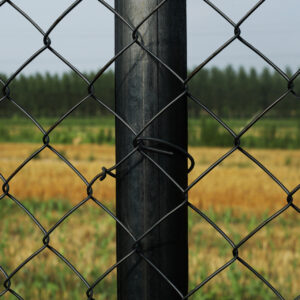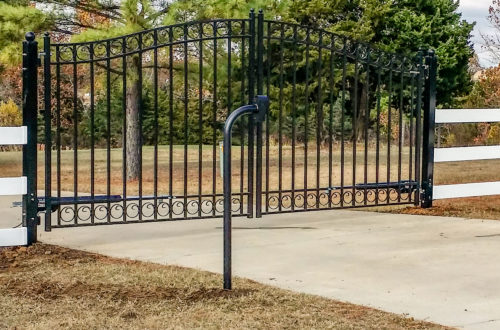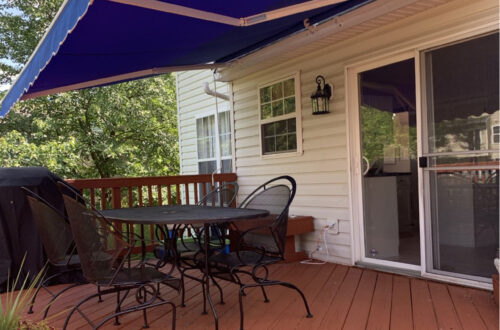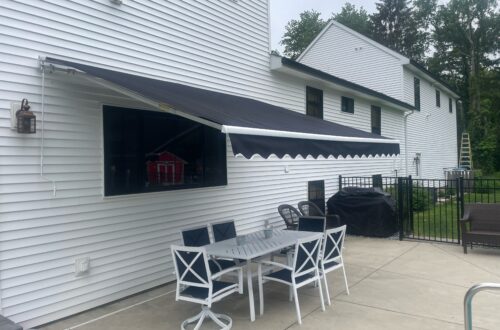There’s something undeniably striking about a metal fence. Whether it’s wrought iron or galvanized steel, metal fences add depth, dimension, and sophistication to a home—to say nothing of the protection they can offer.
If you’ve been admiring your neighbor’s elegant steel fence or keep pausing over those featured in Better Homes & Gardens, trust that modern, regular metal and aluminum fence installation kits have simplified the process. With a few extra hands for assistance, quality metal fencing kits, and our expert tips in your back pocket, you too can have a wrought iron style fence that’ll turn heads—and bring a smile to your face.
Read on for our step-by-step guide on how to install a metal fence and why, precisely, you should consider investing in one.
#1 Select Your Metal Fence
This is the fun part: Choosing from the types of metal fencing that will boost your comfort and your home’s appearance.
Wooden and vinyl fences have their own beauty and benefits, but steel fences have become steadily more popular. Why? They’re durable, long-lasting, and handsome. The different types of metal fences include:
- Wrought iron – Wrought-iron fences have been elevating homes, buildings, and parks for, well, centuries. Comprised of iron that’s heated and molded into different shapes, wrought iron fences are praised for their strength, endurance, and variety. From arched tops to flat-topped designs, you’re bound to find a design that will complement your home and resonate with your personal aesthetics. They tend to come with a higher price tag, but given their longevity, they’re well worth the cost.
- Cast iron – Cast iron fences bear some similarities to wrought iron: They’re available in a host of shapes and designs and have remarkable resilience. Out of the two, cast iron is a more wallet-friendly option. That said, cast iron isn’t as sturdy as wrought iron and may have a shorter lifespan.
- Steel – Steel fences are a more cost-effective alternative to wrought iron. They are also resistant to rust—a boon for those who live in wet climates like Portland or Seattle—and are available in a handful of designs. What are the drawbacks of steel fences? They’re susceptible to scratching, which can mar the appearance of your fence over time. Unless you use a solid panel of steel fencing, the gaps in steel fences also tend towards the thicker side, which may not provide you with as much privacy as you desire with a privacy fence.
- Chain-link – Chain-link fences are common for three primary reasons: they’re easy on the wallet, useful, and a cinch to install. Their design, however, doesn’t offer much in the way of privacy—unless, of course, you weave in greenery (the chef’s kiss of fencing).
- Aluminum – Aluminum is a terrific choice for those who live in damp climates or who plan to install a fence near their outdoor pool. Aluminum is also resistant to rust and has the power to persevere under various weather conditions. Keep in mind, however, that aluminum is vulnerable to bending if an object strikes it, such as a tree branch during a storm.
Naturally, the type of metal fence you select comes down to the amount you’re willing to pay, the look you covet, the amount of privacy you crave, and how long you intend to keep your fence around. Should none of the above meets your needs; you can also explore wire and corrugated metal.

#2 Assess Your Yard For Obstructions and Utilities
Before measuring the perimeter of your yard—or the space you’d like to enclose with a fence—it’s essential to gain a complete understanding of anything that will be in the way or make for difficult terrain. This may include:
- Hills and slopes
- Boulders
- Trees
- Drainage ditches
Obstacles such as these will have to be worked around—either by adjusting your fence line or removing them when possible (and desired).
It’s just as imperative to keep an eye out for utilities, such as sewage and electrical lines, which are oftentimes buried underground (including abandoned utilities). Puncturing one of these can be tremendously costly, may interrupt your and your neighbors’ access to key services like water and WiFi, and potentially result in fines. Contact your utility company by dialing 811 for more information about how metal fence installation may interrupt services.
#3 Determine Your Property Line
You may have a general understanding of where your property begins and ends, but precision is imperative here. Review your deed or a plat map, or hire a licensed land surveyor.
You may also want to give your immediate neighbors a head’s-up and assure them (with paperwork, if necessary) that your fence will be installed on your property.
#4 Confirm Your Fence’s Height (and Viability)
Local ordinances and HOAs (if you’re part of one) dictate the sizes and heights of fences, so ensure that the fence you’ve selected falls within your region and neighborhood’s range. Further, take a look at your deed for any easements that could interfere with your fencing plans or force you to demolish it in the future.
Lastly, you may need to obtain a permit to construct a steel fence on your property. Contact your county office to guarantee you’re within legal bounds.
#5 Take Measurements

When it comes to answering the question, “How much fence do I need?” you’ll need to know exactly how much steel fencing you’ll require before ordering a fencing kit. Using a measuring wheel or a measuring tape (with an assistant, of course), calculate the perimeter of your yard—or the area you’ve designated for a fence—by feet. Divide this number by the size of the metal fence panels you’ve selected.
#6 Order Your Fence Kit and Obtain The Necessary Tools and Materials
Iron fencing kits usually come with galvanized steel or metal fence panels, posts (including end posts, corner posts, and structural line posts), and connector brackets.
You’ll also need to get your hands on several tools. Normally, these will include:
- Power hill digger or power auger
- Shovel
- Strings
- Stakes
- Spray paint
- Concrete or gravel
If you’re installing a gate, be sure to order it along with your fence kit.
#7 Perform a Test Run
Prior to putting your metal fence in the post holes, you’ll dig (see #9 below). You may want to lay it out to examine how it fits. This will save you from making critical adjustments once your fence is erect.
#8 Stake Out Your Posts’ Positions
Plot out the perimeter of your fence and mark corners and ends with spray paint. Place stakes in these areas and attach strings between them, ensuring the string is taut. With measuring tape, mark where your line posts will go with spray paint according to the panels’ width. Your fencing manufacturer will provide recommendations on the distance you should have between each panel.
#9 Dig Your Post Holes
After staking out where the post holes will be, use a power hill digger or a power auger. Here are a few tips on how to install metal fence posts:
- Dig the hole in a bell shape with the top of the “bell” facing the sky and the wider part at the bottom. This will encourage stability.
- Make each hole the diameter and depth instructed by the fence manufacturer.
- Fill each hole with roughly six inches of gravel. This will drain water away from your posts.
Alternatively, some choose to use cement to keep their posts intact. While you don’t necessarily need concrete, they may be advised if you live in a high-wind area. Be sure to go over this aspect with your fence manufacturer before you dive into the project.
#10 Install Your Panels and Posts
Set your posts into your holes, remembering to use corner posts at any part of the fence that turns at a 90-degree angle. Fasten the posts between each section. (Absolutely ensure you follow the manufacturer’s instructions to the T, as each type of fence has different requirements and measurements between posts.) If you’re using concrete to keep your posts in place, install the posts and panels simultaneously before pouring in the concrete.
Finally, if you’re installing a driveway gate, this will be your final step—either according to the manufacturer’s instructions or for heavier, more intricate wrought iron gates, with the assistance of a contractor.
Then, pat yourself on your back for all of your hard work—and savor the sight of your new metal fence. You’re finished.
Metal Fences: Your Frequently Asked Questions

If you’ve been busy Googling how to install metal fences, you may have questions about metal fences in general. Here are a few of the most common questions people have:
What Are The Benefits of a Metal Fence?
Metal fences have a bevy of benefits, namely:
- Security – You may want to keep your pets within the boundaries of your yard—and keep other animals from meandering onto your property. Similarly, you may want to keep intruders from entering your property, and a metal security fence may help in this regard and enrich your sense of safety.
- Low-maintenance – When it comes to fence maintenance, steel as a fence materials has garnered a glowing reputation for being low maintenance. Clearing your fence of debris, washing it, removing spots of rust, treating—or replacing—your hardware, and performing repairs (when necessary) nearly sums up all you’ll need to do to enjoy a metal fence.
- Curb appeal – Whether your metal fence is a unique, wrought iron design or a classic shape with metal panels, metal fences are a simple and chic way to enrich the attractiveness of your home and yard.
- ROI — While some metal fences are pricier than wooden and vinyl models, they also last. Over the long run, they can be a solid investment and may even increase your home’s value.
How Much Do Metal Fences Cost?
So, how much does a fence cost? The size of your fence and the fencing material (whether that be regular metal or galvanized steel) you choose will determine the total fence cost.
That said, Fixr reports that metal fences usually come in between $3,000 and $5,500.
Here at ALEKO, our DIY wrought iron-style metal fencing kits range between $69.00 and $3,699.00, while our Galvanized Steel metal fence panels are between $579.00 and $3,699.00.
Can I Install a Metal Fence Myself?
Definitely—as long as you have a few helping hands. Our fencing kits, for one, contain everything you need to put up your fence. Managing the job yourself could save you a considerable amount on labor.
Another option would be to opt for chain link fence kits. Visit our blog on How To Install A Chain Link Fence for more information.

Level Up the Beauty of Your Home with ALEKO
Metal and steel fences are an excellent addition to any property—particularly if you choose a gorgeous design that complements your home, landscaping, and neighborhood.
ALEKO has an assortment of expertly-crafted products to turn your dreams of a lovely metal fence into a reality. We also have everything you need to transform your yard into an oasis, including saunas, gazebos, and gates.
Schedule a consultation with one of our representatives today to learn more about the fencing options that will suit your taste, home, and budget.
Sources:
Angi. Explore these popular types of metal fencing for a strong and stunning perimeter.
https://www.angi.com/articles/types-metal-fencing.htm
Forbes Home. How to find your utility lines.
https://www.forbes.com/home-improvement/home/how-to-find-utility-lines/
US News & World Report. How do I find my property lines?
https://realestate.usnews.com/real-estate/articles/how-do-i-find-my-property-lines
Home Garden Guides. Can you build a fence on an easement? https://homegardenguides.com/fencing/can-you-build-fence-on-easement/
Hunker. How to install a metal fence: a diy guide.
https://www.hunker.com/13727354/how-to-install-a-metal-fence-a-diy-guide
Homelight. Does a fence increase home value, or is it just good for pets and privacy?
https://www.homelight.com/blog/does-fence-increase-home-value/
Fixr. How much does it cost to install a metal fence?






